Mobile Communication: Comparing the Features of 2G and 3G Systems
VerifiedAdded on 2023/06/15
|27
|7864
|374
Report
AI Summary
This report provides a detailed comparison of 2G and 3G mobile communication systems, highlighting their evolution from 1G. It discusses the technology, deployment, advantages, and disadvantages of both 2G and 3G networks. The report outlines the transition from 2G to 3G, emphasizing the similarities and differences between the two generations. It also touches on future wireless technologies and their potential impact on mobile communications. The analysis covers various aspects, including data services, signal types, battery power consumption, security features, and the reduction of noise in communication lines. The report concludes by summarizing the key advancements and future trends in mobile communication technology.

Running head: 2G vs. 3G
A Detailed Comparison of Second Generation and Third Generation Mobile
Communications Systems
Name of the Student
Name of the University
Author’s Note:
A Detailed Comparison of Second Generation and Third Generation Mobile
Communications Systems
Name of the Student
Name of the University
Author’s Note:
Paraphrase This Document
Need a fresh take? Get an instant paraphrase of this document with our AI Paraphraser
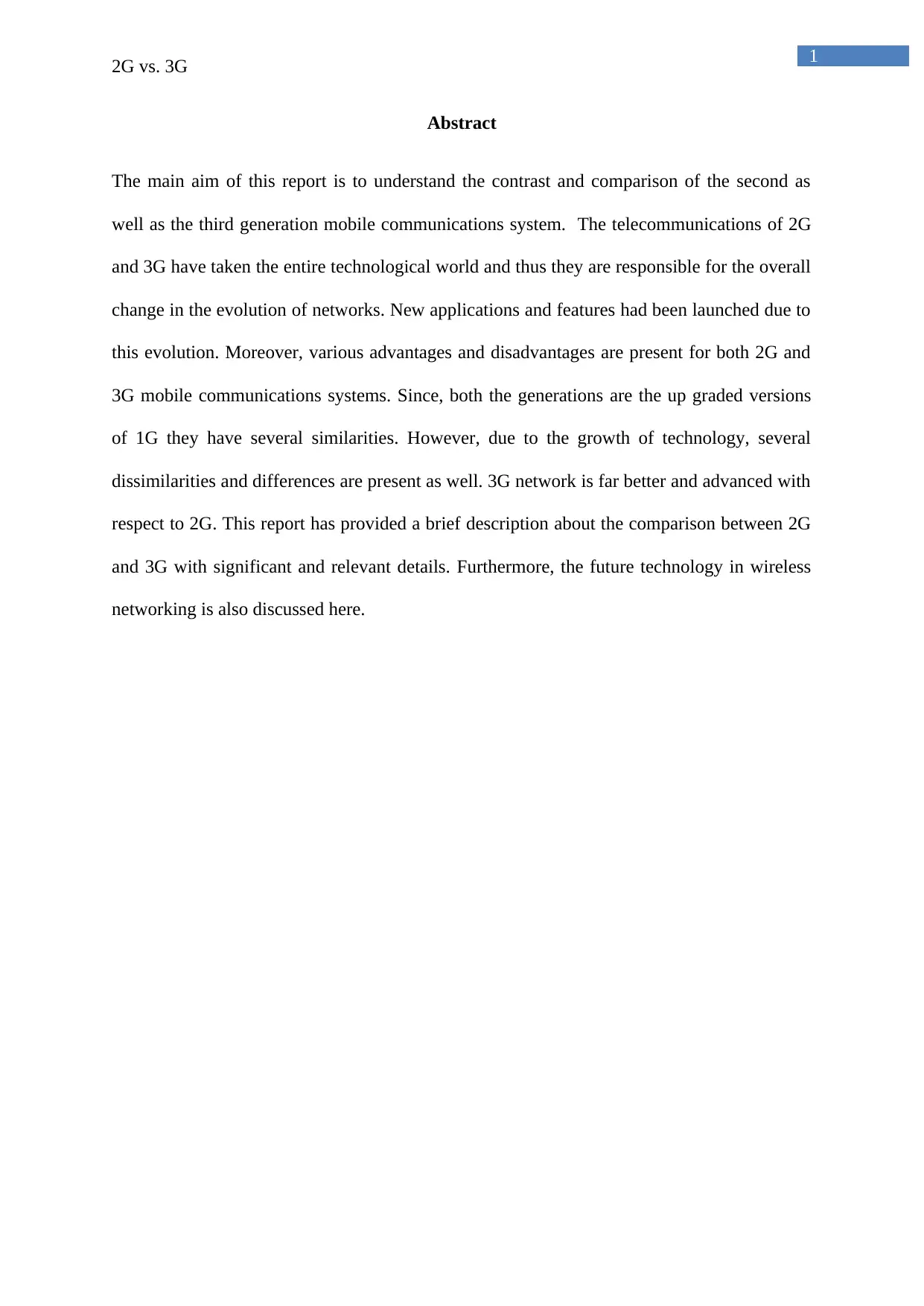
1
2G vs. 3G
Abstract
The main aim of this report is to understand the contrast and comparison of the second as
well as the third generation mobile communications system. The telecommunications of 2G
and 3G have taken the entire technological world and thus they are responsible for the overall
change in the evolution of networks. New applications and features had been launched due to
this evolution. Moreover, various advantages and disadvantages are present for both 2G and
3G mobile communications systems. Since, both the generations are the up graded versions
of 1G they have several similarities. However, due to the growth of technology, several
dissimilarities and differences are present as well. 3G network is far better and advanced with
respect to 2G. This report has provided a brief description about the comparison between 2G
and 3G with significant and relevant details. Furthermore, the future technology in wireless
networking is also discussed here.
2G vs. 3G
Abstract
The main aim of this report is to understand the contrast and comparison of the second as
well as the third generation mobile communications system. The telecommunications of 2G
and 3G have taken the entire technological world and thus they are responsible for the overall
change in the evolution of networks. New applications and features had been launched due to
this evolution. Moreover, various advantages and disadvantages are present for both 2G and
3G mobile communications systems. Since, both the generations are the up graded versions
of 1G they have several similarities. However, due to the growth of technology, several
dissimilarities and differences are present as well. 3G network is far better and advanced with
respect to 2G. This report has provided a brief description about the comparison between 2G
and 3G with significant and relevant details. Furthermore, the future technology in wireless
networking is also discussed here.
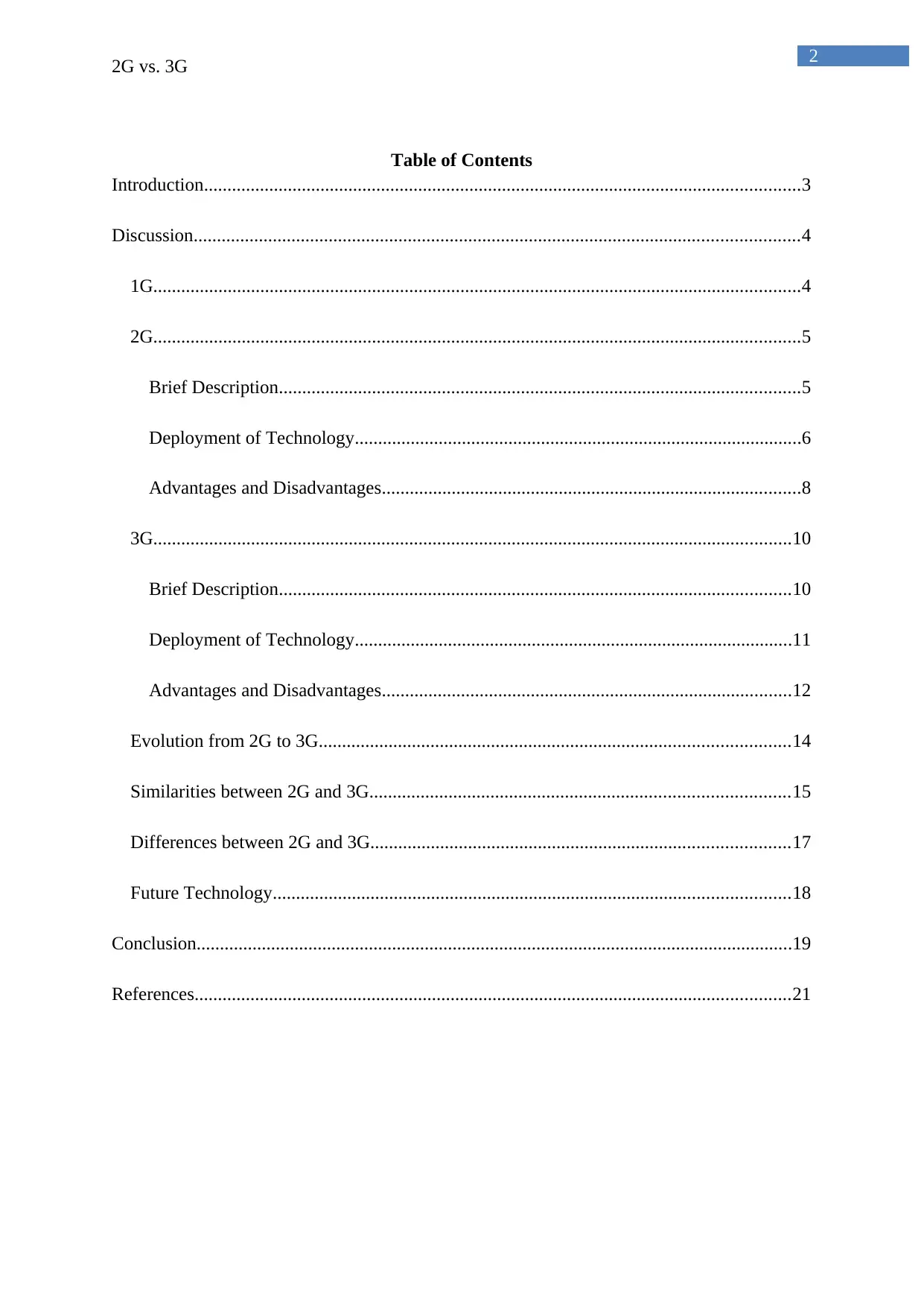
2
2G vs. 3G
Table of Contents
Introduction................................................................................................................................3
Discussion..................................................................................................................................4
1G...........................................................................................................................................4
2G...........................................................................................................................................5
Brief Description................................................................................................................5
Deployment of Technology................................................................................................6
Advantages and Disadvantages..........................................................................................8
3G.........................................................................................................................................10
Brief Description..............................................................................................................10
Deployment of Technology..............................................................................................11
Advantages and Disadvantages........................................................................................12
Evolution from 2G to 3G.....................................................................................................14
Similarities between 2G and 3G..........................................................................................15
Differences between 2G and 3G..........................................................................................17
Future Technology...............................................................................................................18
Conclusion................................................................................................................................19
References................................................................................................................................21
2G vs. 3G
Table of Contents
Introduction................................................................................................................................3
Discussion..................................................................................................................................4
1G...........................................................................................................................................4
2G...........................................................................................................................................5
Brief Description................................................................................................................5
Deployment of Technology................................................................................................6
Advantages and Disadvantages..........................................................................................8
3G.........................................................................................................................................10
Brief Description..............................................................................................................10
Deployment of Technology..............................................................................................11
Advantages and Disadvantages........................................................................................12
Evolution from 2G to 3G.....................................................................................................14
Similarities between 2G and 3G..........................................................................................15
Differences between 2G and 3G..........................................................................................17
Future Technology...............................................................................................................18
Conclusion................................................................................................................................19
References................................................................................................................................21
⊘ This is a preview!⊘
Do you want full access?
Subscribe today to unlock all pages.

Trusted by 1+ million students worldwide
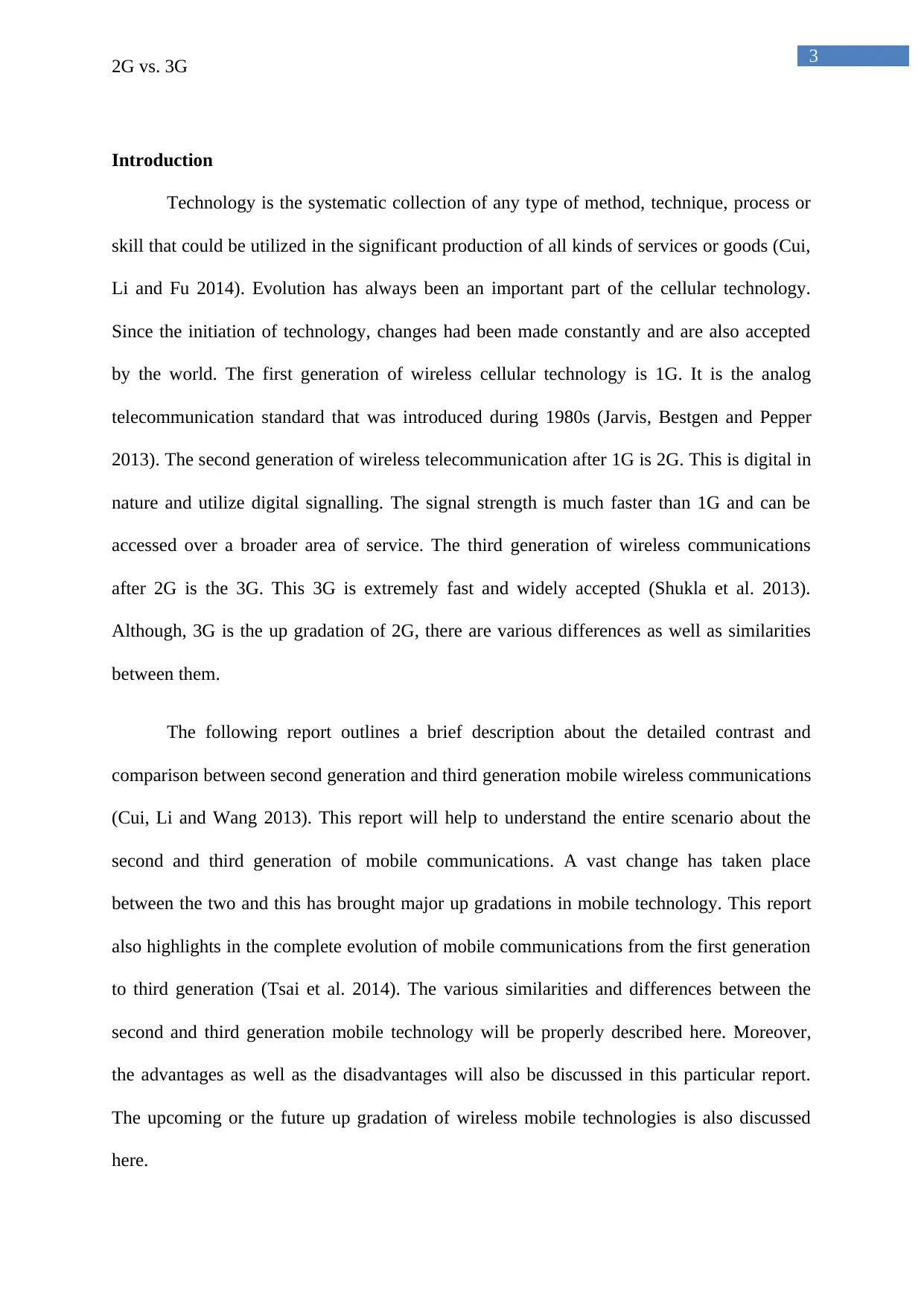
3
2G vs. 3G
Introduction
Technology is the systematic collection of any type of method, technique, process or
skill that could be utilized in the significant production of all kinds of services or goods (Cui,
Li and Fu 2014). Evolution has always been an important part of the cellular technology.
Since the initiation of technology, changes had been made constantly and are also accepted
by the world. The first generation of wireless cellular technology is 1G. It is the analog
telecommunication standard that was introduced during 1980s (Jarvis, Bestgen and Pepper
2013). The second generation of wireless telecommunication after 1G is 2G. This is digital in
nature and utilize digital signalling. The signal strength is much faster than 1G and can be
accessed over a broader area of service. The third generation of wireless communications
after 2G is the 3G. This 3G is extremely fast and widely accepted (Shukla et al. 2013).
Although, 3G is the up gradation of 2G, there are various differences as well as similarities
between them.
The following report outlines a brief description about the detailed contrast and
comparison between second generation and third generation mobile wireless communications
(Cui, Li and Wang 2013). This report will help to understand the entire scenario about the
second and third generation of mobile communications. A vast change has taken place
between the two and this has brought major up gradations in mobile technology. This report
also highlights in the complete evolution of mobile communications from the first generation
to third generation (Tsai et al. 2014). The various similarities and differences between the
second and third generation mobile technology will be properly described here. Moreover,
the advantages as well as the disadvantages will also be discussed in this particular report.
The upcoming or the future up gradation of wireless mobile technologies is also discussed
here.
2G vs. 3G
Introduction
Technology is the systematic collection of any type of method, technique, process or
skill that could be utilized in the significant production of all kinds of services or goods (Cui,
Li and Fu 2014). Evolution has always been an important part of the cellular technology.
Since the initiation of technology, changes had been made constantly and are also accepted
by the world. The first generation of wireless cellular technology is 1G. It is the analog
telecommunication standard that was introduced during 1980s (Jarvis, Bestgen and Pepper
2013). The second generation of wireless telecommunication after 1G is 2G. This is digital in
nature and utilize digital signalling. The signal strength is much faster than 1G and can be
accessed over a broader area of service. The third generation of wireless communications
after 2G is the 3G. This 3G is extremely fast and widely accepted (Shukla et al. 2013).
Although, 3G is the up gradation of 2G, there are various differences as well as similarities
between them.
The following report outlines a brief description about the detailed contrast and
comparison between second generation and third generation mobile wireless communications
(Cui, Li and Wang 2013). This report will help to understand the entire scenario about the
second and third generation of mobile communications. A vast change has taken place
between the two and this has brought major up gradations in mobile technology. This report
also highlights in the complete evolution of mobile communications from the first generation
to third generation (Tsai et al. 2014). The various similarities and differences between the
second and third generation mobile technology will be properly described here. Moreover,
the advantages as well as the disadvantages will also be discussed in this particular report.
The upcoming or the future up gradation of wireless mobile technologies is also discussed
here.
Paraphrase This Document
Need a fresh take? Get an instant paraphrase of this document with our AI Paraphraser

4
2G vs. 3G
Discussion
1G
The first generation of wireless mobile communications is known as 1G. The first
generation of mobile technology was introduced in the year 1980 in Japan and it was solely
continued until it was replaced by the second generation (Cui, Li and Wang 2013). The major
difference between the first and the second generation cellular systems is the vast utilization
of several radio signals by the analog networks of 1G and the digital networks of 2G.
However, both of the systems utilize digital signalling for the successful connection of radio
towers with the remaining system of telephone (Deng et al. 2013). The voice that is heard
while calling somebody is usually encoded to digital signals in the second generation,
whereas in the first generation the voice over call is simply modulated to the higher
frequency. The minimum frequency for the first generation mobile communications is around
150 MHz. The obvious advantage or benefit of the digital technology over the analog
technology is that the second generation networks can be easily replaced everywhere (Feng et
al. 2015). The best example of this type of standard is the NMT or Nordic Mobile Telephone
that are utilized in various Nordic countries like the Netherlands, Switzerland, Russia and
Eastern Europe. The second example is the AMPS or Advanced Mobile Phone System that is
utilized in Australia and North America.
The advantages or benefits of the first generation mobile communications system are
as follows:
i) Easy to Use: This type of mobile communications system is extremely easy to use
and can be utilized in broad area of service (Sulyman et al. 2014).
2G vs. 3G
Discussion
1G
The first generation of wireless mobile communications is known as 1G. The first
generation of mobile technology was introduced in the year 1980 in Japan and it was solely
continued until it was replaced by the second generation (Cui, Li and Wang 2013). The major
difference between the first and the second generation cellular systems is the vast utilization
of several radio signals by the analog networks of 1G and the digital networks of 2G.
However, both of the systems utilize digital signalling for the successful connection of radio
towers with the remaining system of telephone (Deng et al. 2013). The voice that is heard
while calling somebody is usually encoded to digital signals in the second generation,
whereas in the first generation the voice over call is simply modulated to the higher
frequency. The minimum frequency for the first generation mobile communications is around
150 MHz. The obvious advantage or benefit of the digital technology over the analog
technology is that the second generation networks can be easily replaced everywhere (Feng et
al. 2015). The best example of this type of standard is the NMT or Nordic Mobile Telephone
that are utilized in various Nordic countries like the Netherlands, Switzerland, Russia and
Eastern Europe. The second example is the AMPS or Advanced Mobile Phone System that is
utilized in Australia and North America.
The advantages or benefits of the first generation mobile communications system are
as follows:
i) Easy to Use: This type of mobile communications system is extremely easy to use
and can be utilized in broad area of service (Sulyman et al. 2014).
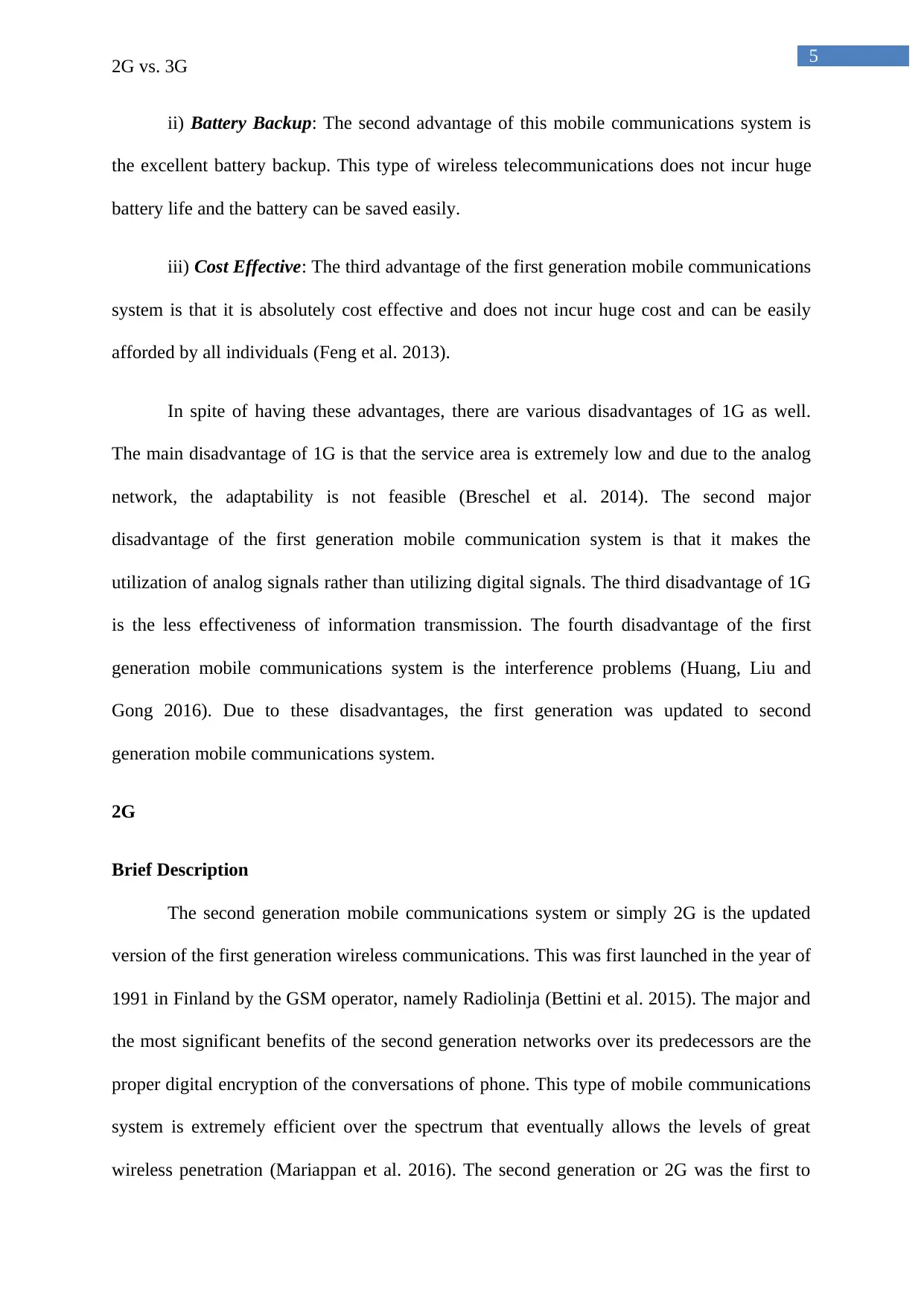
5
2G vs. 3G
ii) Battery Backup: The second advantage of this mobile communications system is
the excellent battery backup. This type of wireless telecommunications does not incur huge
battery life and the battery can be saved easily.
iii) Cost Effective: The third advantage of the first generation mobile communications
system is that it is absolutely cost effective and does not incur huge cost and can be easily
afforded by all individuals (Feng et al. 2013).
In spite of having these advantages, there are various disadvantages of 1G as well.
The main disadvantage of 1G is that the service area is extremely low and due to the analog
network, the adaptability is not feasible (Breschel et al. 2014). The second major
disadvantage of the first generation mobile communication system is that it makes the
utilization of analog signals rather than utilizing digital signals. The third disadvantage of 1G
is the less effectiveness of information transmission. The fourth disadvantage of the first
generation mobile communications system is the interference problems (Huang, Liu and
Gong 2016). Due to these disadvantages, the first generation was updated to second
generation mobile communications system.
2G
Brief Description
The second generation mobile communications system or simply 2G is the updated
version of the first generation wireless communications. This was first launched in the year of
1991 in Finland by the GSM operator, namely Radiolinja (Bettini et al. 2015). The major and
the most significant benefits of the second generation networks over its predecessors are the
proper digital encryption of the conversations of phone. This type of mobile communications
system is extremely efficient over the spectrum that eventually allows the levels of great
wireless penetration (Mariappan et al. 2016). The second generation or 2G was the first to
2G vs. 3G
ii) Battery Backup: The second advantage of this mobile communications system is
the excellent battery backup. This type of wireless telecommunications does not incur huge
battery life and the battery can be saved easily.
iii) Cost Effective: The third advantage of the first generation mobile communications
system is that it is absolutely cost effective and does not incur huge cost and can be easily
afforded by all individuals (Feng et al. 2013).
In spite of having these advantages, there are various disadvantages of 1G as well.
The main disadvantage of 1G is that the service area is extremely low and due to the analog
network, the adaptability is not feasible (Breschel et al. 2014). The second major
disadvantage of the first generation mobile communication system is that it makes the
utilization of analog signals rather than utilizing digital signals. The third disadvantage of 1G
is the less effectiveness of information transmission. The fourth disadvantage of the first
generation mobile communications system is the interference problems (Huang, Liu and
Gong 2016). Due to these disadvantages, the first generation was updated to second
generation mobile communications system.
2G
Brief Description
The second generation mobile communications system or simply 2G is the updated
version of the first generation wireless communications. This was first launched in the year of
1991 in Finland by the GSM operator, namely Radiolinja (Bettini et al. 2015). The major and
the most significant benefits of the second generation networks over its predecessors are the
proper digital encryption of the conversations of phone. This type of mobile communications
system is extremely efficient over the spectrum that eventually allows the levels of great
wireless penetration (Mariappan et al. 2016). The second generation or 2G was the first to
⊘ This is a preview!⊘
Do you want full access?
Subscribe today to unlock all pages.

Trusted by 1+ million students worldwide

6
2G vs. 3G
introduce the data services for the mobile phones. The several networks were enabled for
providing various services like picture messages, multimedia messages and also text
messages by the technology of 2G. The text messages that are eventually sent over the second
generation are always digitally encrypted and this allows the successful transmission of data
(Singh, Rawat and Bonnin 2014). The data is transferred in such a typical way that only the
receiver, who is intended to receive the message, will receive as well as read it.
Deployment of Technology
When the second generation was launched, all the previous network systems of
mobile wireless were actively stopped. The radio signal of this 2G network is digital in nature
(Hadzialic et al. 2013). These digital signals are utilized for the successful connection of
radio towers with the remaining mobile system. Although, 2G or the second generation
networks are backdated and slow, it is still used in many parts of the world in today’s world.
With the help of GPRS or the General Packet Radio Service, the second generation mobile
communications system provides a theoretical maximum speed of data transfer of 50 kilo bits
per second (Pizzinat et al. 2015). In practice, this speed is about 40 kilo bits per second. With
the help of EDGE or Enhanced Data Rates for GSM Evolution, the second generation mobile
communications system provides a theoretical maximum speed of data transfer of 1 Mega bit
per second. However, in practice, this speed is not more than 500 kilo bits per second. GPRS
or General Packet Radio Service was known as 2.5G or second and a half generation and was
utilized for describing the systems of 2G, which implements a packet switched domain with
the domain of circuit switch (Ferlin, Dreibholz and Alay 2014). It provides faster services
than 2G as the timeslots bundling is eventually utilized for the purpose of circuit switching
services of data or HSCSD. The up graded version of 2.5G is the 2.75G or EDGE. The
enhanced data rates for GSM Evolution or EDGE is the evolution of GPRS networks with the
significant introduction of 8 phase shift keying encoding. The rate of symbol is same as the
2G vs. 3G
introduce the data services for the mobile phones. The several networks were enabled for
providing various services like picture messages, multimedia messages and also text
messages by the technology of 2G. The text messages that are eventually sent over the second
generation are always digitally encrypted and this allows the successful transmission of data
(Singh, Rawat and Bonnin 2014). The data is transferred in such a typical way that only the
receiver, who is intended to receive the message, will receive as well as read it.
Deployment of Technology
When the second generation was launched, all the previous network systems of
mobile wireless were actively stopped. The radio signal of this 2G network is digital in nature
(Hadzialic et al. 2013). These digital signals are utilized for the successful connection of
radio towers with the remaining mobile system. Although, 2G or the second generation
networks are backdated and slow, it is still used in many parts of the world in today’s world.
With the help of GPRS or the General Packet Radio Service, the second generation mobile
communications system provides a theoretical maximum speed of data transfer of 50 kilo bits
per second (Pizzinat et al. 2015). In practice, this speed is about 40 kilo bits per second. With
the help of EDGE or Enhanced Data Rates for GSM Evolution, the second generation mobile
communications system provides a theoretical maximum speed of data transfer of 1 Mega bit
per second. However, in practice, this speed is not more than 500 kilo bits per second. GPRS
or General Packet Radio Service was known as 2.5G or second and a half generation and was
utilized for describing the systems of 2G, which implements a packet switched domain with
the domain of circuit switch (Ferlin, Dreibholz and Alay 2014). It provides faster services
than 2G as the timeslots bundling is eventually utilized for the purpose of circuit switching
services of data or HSCSD. The up graded version of 2.5G is the 2.75G or EDGE. The
enhanced data rates for GSM Evolution or EDGE is the evolution of GPRS networks with the
significant introduction of 8 phase shift keying encoding. The rate of symbol is same as the
Paraphrase This Document
Need a fresh take? Get an instant paraphrase of this document with our AI Paraphraser

7
2G vs. 3G
270.833 samples in one second and every symbol happened to carry three bits instead of one
single bit (Cvijetic et al. 2013). The enhanced data rates for GSM evolution or EDGE,
Enhanced GPRS or EGPRS and IMTSC or IMT Single Carrier is the technology of backward
compatible digital mobile phone, which enables improvised rate of transmission of data as the
extension of standard GSM. The deployment of EDGE on the network of GSM was done in
the year of 2003.
The most significant or common technology of 2G was the TDMA or time division
multiple access based GSM. This was basically from Europe, however it was utilized
maximum in the parts outside North America (Quan, Li and Tentzeris 2013). By the year of
2010, more than sixty GSM operators were eventually utilizing the CDMA 2000 in the
frequency band of 450 MHz. This frequency band is also known as CDMA 450.
2G was shut down in various parts of the world. In the United States, several carriers
decided to shut the technology of 2G for the purpose of reclaiming of new technologies. In
January 2017, the 2G service was shut down in America (Kwon and Han 2014). This was the
most notable impact on the industry of electronic security. Moreover, popular
telecommunication organization, Verizon has decided to shut down the network of 2G
CDMA 1X by the end of year 2019. The most famous telecommunication organization of
Australia, Telstra has closed the 2G in the year of 2016. Optus of Northern Australia has shut
down 2G on 1st April 2017 (Sun et al. 2014). Reliance Communications had taken the
decision of shutting down of the second generation by the end of November 2017 and
became the first organization to take such decision in India. Apart from these above
mentioned countries, the other countries like New Zealand, Singapore, Netherlands,
Switzerland and many more have shut down the communications system of 2G.
2G vs. 3G
270.833 samples in one second and every symbol happened to carry three bits instead of one
single bit (Cvijetic et al. 2013). The enhanced data rates for GSM evolution or EDGE,
Enhanced GPRS or EGPRS and IMTSC or IMT Single Carrier is the technology of backward
compatible digital mobile phone, which enables improvised rate of transmission of data as the
extension of standard GSM. The deployment of EDGE on the network of GSM was done in
the year of 2003.
The most significant or common technology of 2G was the TDMA or time division
multiple access based GSM. This was basically from Europe, however it was utilized
maximum in the parts outside North America (Quan, Li and Tentzeris 2013). By the year of
2010, more than sixty GSM operators were eventually utilizing the CDMA 2000 in the
frequency band of 450 MHz. This frequency band is also known as CDMA 450.
2G was shut down in various parts of the world. In the United States, several carriers
decided to shut the technology of 2G for the purpose of reclaiming of new technologies. In
January 2017, the 2G service was shut down in America (Kwon and Han 2014). This was the
most notable impact on the industry of electronic security. Moreover, popular
telecommunication organization, Verizon has decided to shut down the network of 2G
CDMA 1X by the end of year 2019. The most famous telecommunication organization of
Australia, Telstra has closed the 2G in the year of 2016. Optus of Northern Australia has shut
down 2G on 1st April 2017 (Sun et al. 2014). Reliance Communications had taken the
decision of shutting down of the second generation by the end of November 2017 and
became the first organization to take such decision in India. Apart from these above
mentioned countries, the other countries like New Zealand, Singapore, Netherlands,
Switzerland and many more have shut down the communications system of 2G.
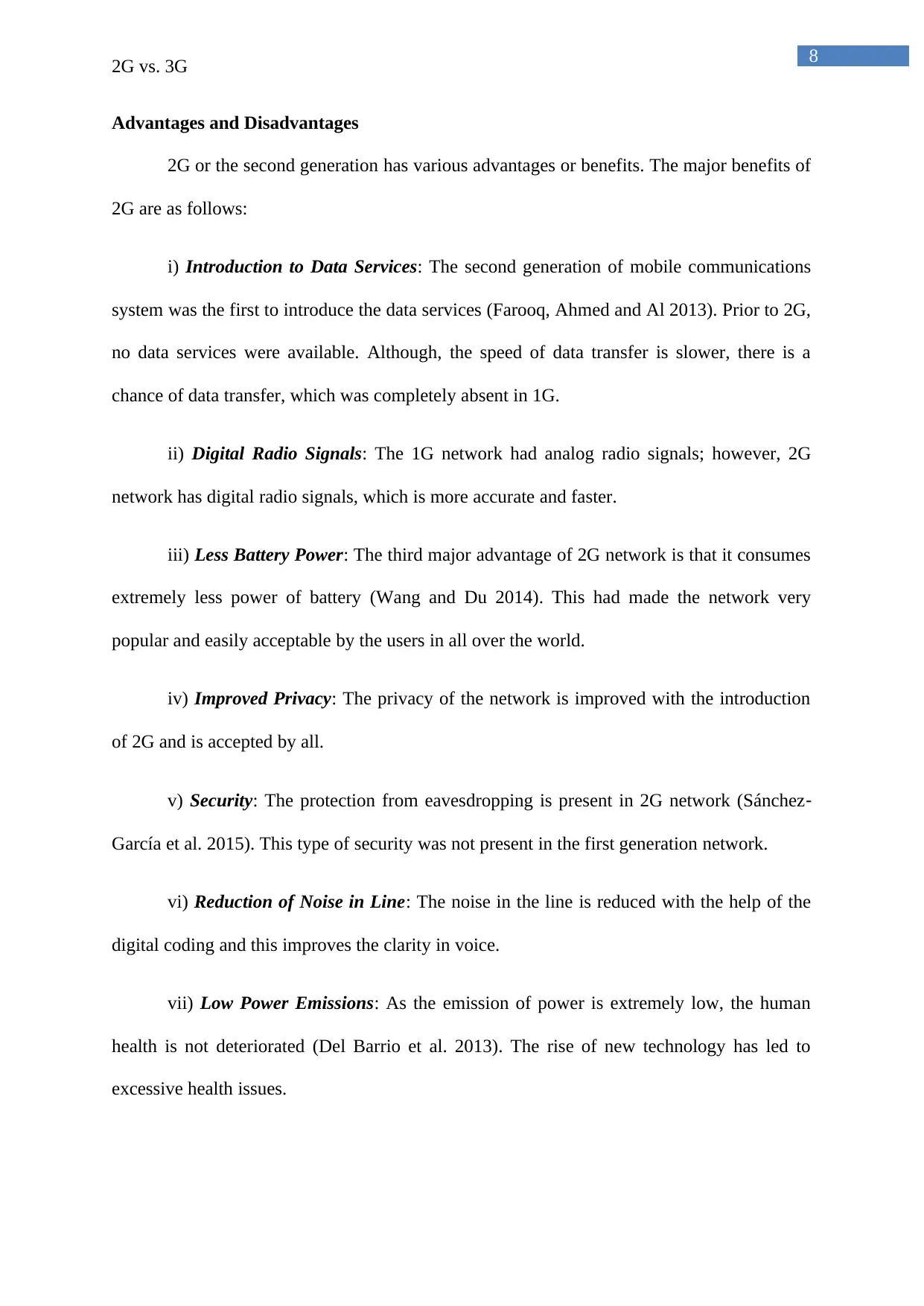
8
2G vs. 3G
Advantages and Disadvantages
2G or the second generation has various advantages or benefits. The major benefits of
2G are as follows:
i) Introduction to Data Services: The second generation of mobile communications
system was the first to introduce the data services (Farooq, Ahmed and Al 2013). Prior to 2G,
no data services were available. Although, the speed of data transfer is slower, there is a
chance of data transfer, which was completely absent in 1G.
ii) Digital Radio Signals: The 1G network had analog radio signals; however, 2G
network has digital radio signals, which is more accurate and faster.
iii) Less Battery Power: The third major advantage of 2G network is that it consumes
extremely less power of battery (Wang and Du 2014). This had made the network very
popular and easily acceptable by the users in all over the world.
iv) Improved Privacy: The privacy of the network is improved with the introduction
of 2G and is accepted by all.
v) Security: The protection from eavesdropping is present in 2G network (Sánchez‐
García et al. 2015). This type of security was not present in the first generation network.
vi) Reduction of Noise in Line: The noise in the line is reduced with the help of the
digital coding and this improves the clarity in voice.
vii) Low Power Emissions: As the emission of power is extremely low, the human
health is not deteriorated (Del Barrio et al. 2013). The rise of new technology has led to
excessive health issues.
2G vs. 3G
Advantages and Disadvantages
2G or the second generation has various advantages or benefits. The major benefits of
2G are as follows:
i) Introduction to Data Services: The second generation of mobile communications
system was the first to introduce the data services (Farooq, Ahmed and Al 2013). Prior to 2G,
no data services were available. Although, the speed of data transfer is slower, there is a
chance of data transfer, which was completely absent in 1G.
ii) Digital Radio Signals: The 1G network had analog radio signals; however, 2G
network has digital radio signals, which is more accurate and faster.
iii) Less Battery Power: The third major advantage of 2G network is that it consumes
extremely less power of battery (Wang and Du 2014). This had made the network very
popular and easily acceptable by the users in all over the world.
iv) Improved Privacy: The privacy of the network is improved with the introduction
of 2G and is accepted by all.
v) Security: The protection from eavesdropping is present in 2G network (Sánchez‐
García et al. 2015). This type of security was not present in the first generation network.
vi) Reduction of Noise in Line: The noise in the line is reduced with the help of the
digital coding and this improves the clarity in voice.
vii) Low Power Emissions: As the emission of power is extremely low, the human
health is not deteriorated (Del Barrio et al. 2013). The rise of new technology has led to
excessive health issues.
⊘ This is a preview!⊘
Do you want full access?
Subscribe today to unlock all pages.

Trusted by 1+ million students worldwide
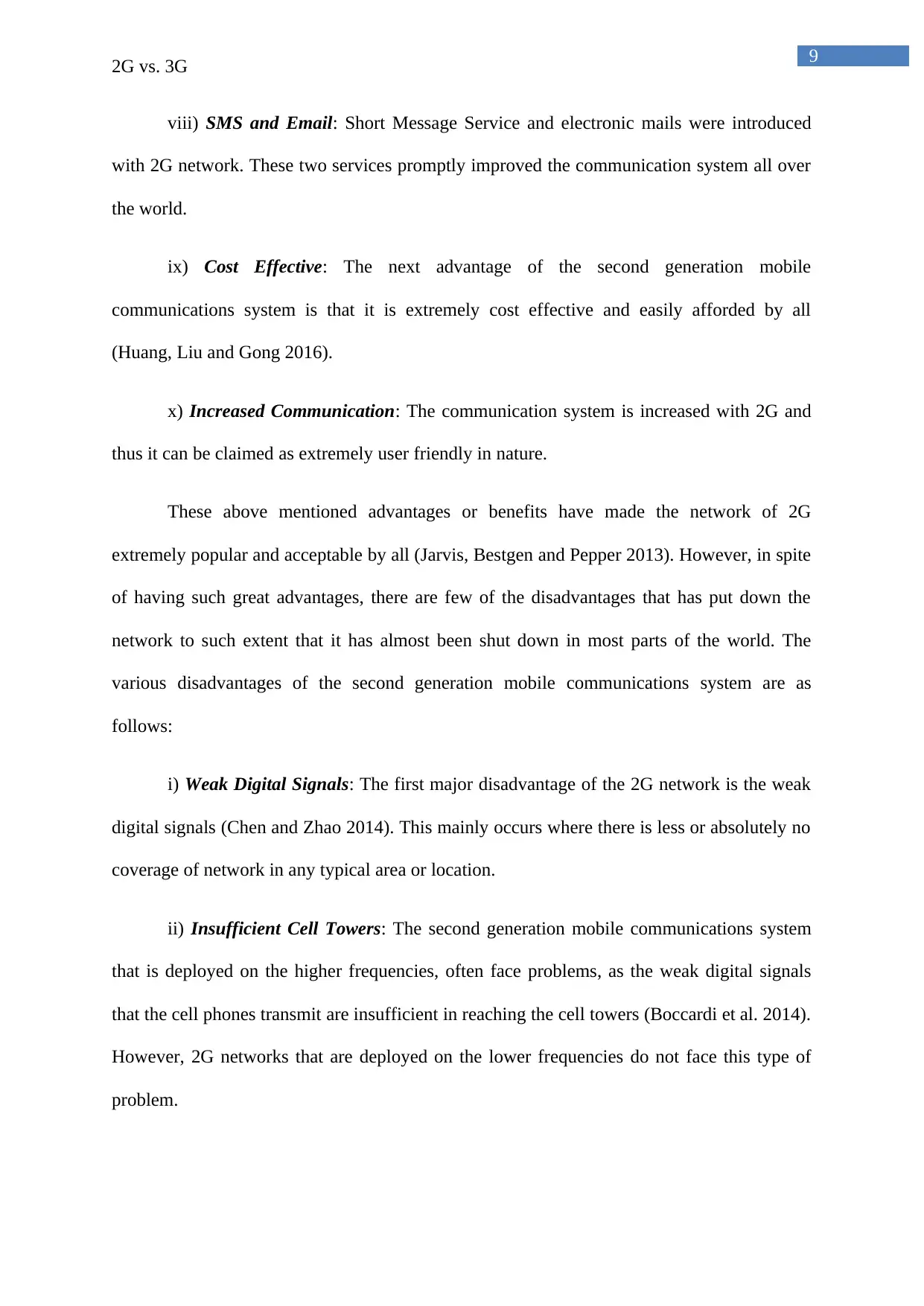
9
2G vs. 3G
viii) SMS and Email: Short Message Service and electronic mails were introduced
with 2G network. These two services promptly improved the communication system all over
the world.
ix) Cost Effective: The next advantage of the second generation mobile
communications system is that it is extremely cost effective and easily afforded by all
(Huang, Liu and Gong 2016).
x) Increased Communication: The communication system is increased with 2G and
thus it can be claimed as extremely user friendly in nature.
These above mentioned advantages or benefits have made the network of 2G
extremely popular and acceptable by all (Jarvis, Bestgen and Pepper 2013). However, in spite
of having such great advantages, there are few of the disadvantages that has put down the
network to such extent that it has almost been shut down in most parts of the world. The
various disadvantages of the second generation mobile communications system are as
follows:
i) Weak Digital Signals: The first major disadvantage of the 2G network is the weak
digital signals (Chen and Zhao 2014). This mainly occurs where there is less or absolutely no
coverage of network in any typical area or location.
ii) Insufficient Cell Towers: The second generation mobile communications system
that is deployed on the higher frequencies, often face problems, as the weak digital signals
that the cell phones transmit are insufficient in reaching the cell towers (Boccardi et al. 2014).
However, 2G networks that are deployed on the lower frequencies do not face this type of
problem.
2G vs. 3G
viii) SMS and Email: Short Message Service and electronic mails were introduced
with 2G network. These two services promptly improved the communication system all over
the world.
ix) Cost Effective: The next advantage of the second generation mobile
communications system is that it is extremely cost effective and easily afforded by all
(Huang, Liu and Gong 2016).
x) Increased Communication: The communication system is increased with 2G and
thus it can be claimed as extremely user friendly in nature.
These above mentioned advantages or benefits have made the network of 2G
extremely popular and acceptable by all (Jarvis, Bestgen and Pepper 2013). However, in spite
of having such great advantages, there are few of the disadvantages that has put down the
network to such extent that it has almost been shut down in most parts of the world. The
various disadvantages of the second generation mobile communications system are as
follows:
i) Weak Digital Signals: The first major disadvantage of the 2G network is the weak
digital signals (Chen and Zhao 2014). This mainly occurs where there is less or absolutely no
coverage of network in any typical area or location.
ii) Insufficient Cell Towers: The second generation mobile communications system
that is deployed on the higher frequencies, often face problems, as the weak digital signals
that the cell phones transmit are insufficient in reaching the cell towers (Boccardi et al. 2014).
However, 2G networks that are deployed on the lower frequencies do not face this type of
problem.
Paraphrase This Document
Need a fresh take? Get an instant paraphrase of this document with our AI Paraphraser
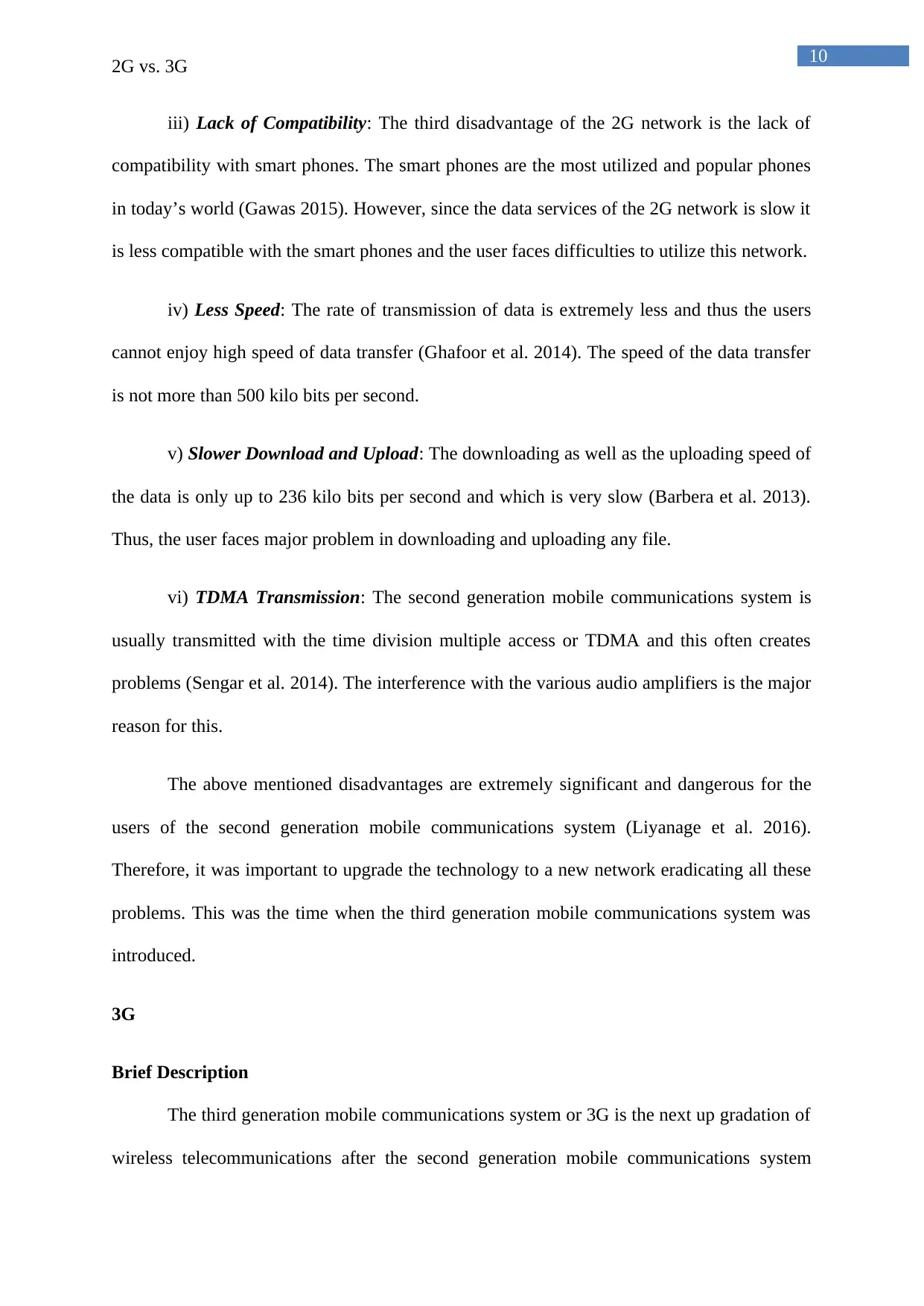
10
2G vs. 3G
iii) Lack of Compatibility: The third disadvantage of the 2G network is the lack of
compatibility with smart phones. The smart phones are the most utilized and popular phones
in today’s world (Gawas 2015). However, since the data services of the 2G network is slow it
is less compatible with the smart phones and the user faces difficulties to utilize this network.
iv) Less Speed: The rate of transmission of data is extremely less and thus the users
cannot enjoy high speed of data transfer (Ghafoor et al. 2014). The speed of the data transfer
is not more than 500 kilo bits per second.
v) Slower Download and Upload: The downloading as well as the uploading speed of
the data is only up to 236 kilo bits per second and which is very slow (Barbera et al. 2013).
Thus, the user faces major problem in downloading and uploading any file.
vi) TDMA Transmission: The second generation mobile communications system is
usually transmitted with the time division multiple access or TDMA and this often creates
problems (Sengar et al. 2014). The interference with the various audio amplifiers is the major
reason for this.
The above mentioned disadvantages are extremely significant and dangerous for the
users of the second generation mobile communications system (Liyanage et al. 2016).
Therefore, it was important to upgrade the technology to a new network eradicating all these
problems. This was the time when the third generation mobile communications system was
introduced.
3G
Brief Description
The third generation mobile communications system or 3G is the next up gradation of
wireless telecommunications after the second generation mobile communications system
2G vs. 3G
iii) Lack of Compatibility: The third disadvantage of the 2G network is the lack of
compatibility with smart phones. The smart phones are the most utilized and popular phones
in today’s world (Gawas 2015). However, since the data services of the 2G network is slow it
is less compatible with the smart phones and the user faces difficulties to utilize this network.
iv) Less Speed: The rate of transmission of data is extremely less and thus the users
cannot enjoy high speed of data transfer (Ghafoor et al. 2014). The speed of the data transfer
is not more than 500 kilo bits per second.
v) Slower Download and Upload: The downloading as well as the uploading speed of
the data is only up to 236 kilo bits per second and which is very slow (Barbera et al. 2013).
Thus, the user faces major problem in downloading and uploading any file.
vi) TDMA Transmission: The second generation mobile communications system is
usually transmitted with the time division multiple access or TDMA and this often creates
problems (Sengar et al. 2014). The interference with the various audio amplifiers is the major
reason for this.
The above mentioned disadvantages are extremely significant and dangerous for the
users of the second generation mobile communications system (Liyanage et al. 2016).
Therefore, it was important to upgrade the technology to a new network eradicating all these
problems. This was the time when the third generation mobile communications system was
introduced.
3G
Brief Description
The third generation mobile communications system or 3G is the next up gradation of
wireless telecommunications after the second generation mobile communications system
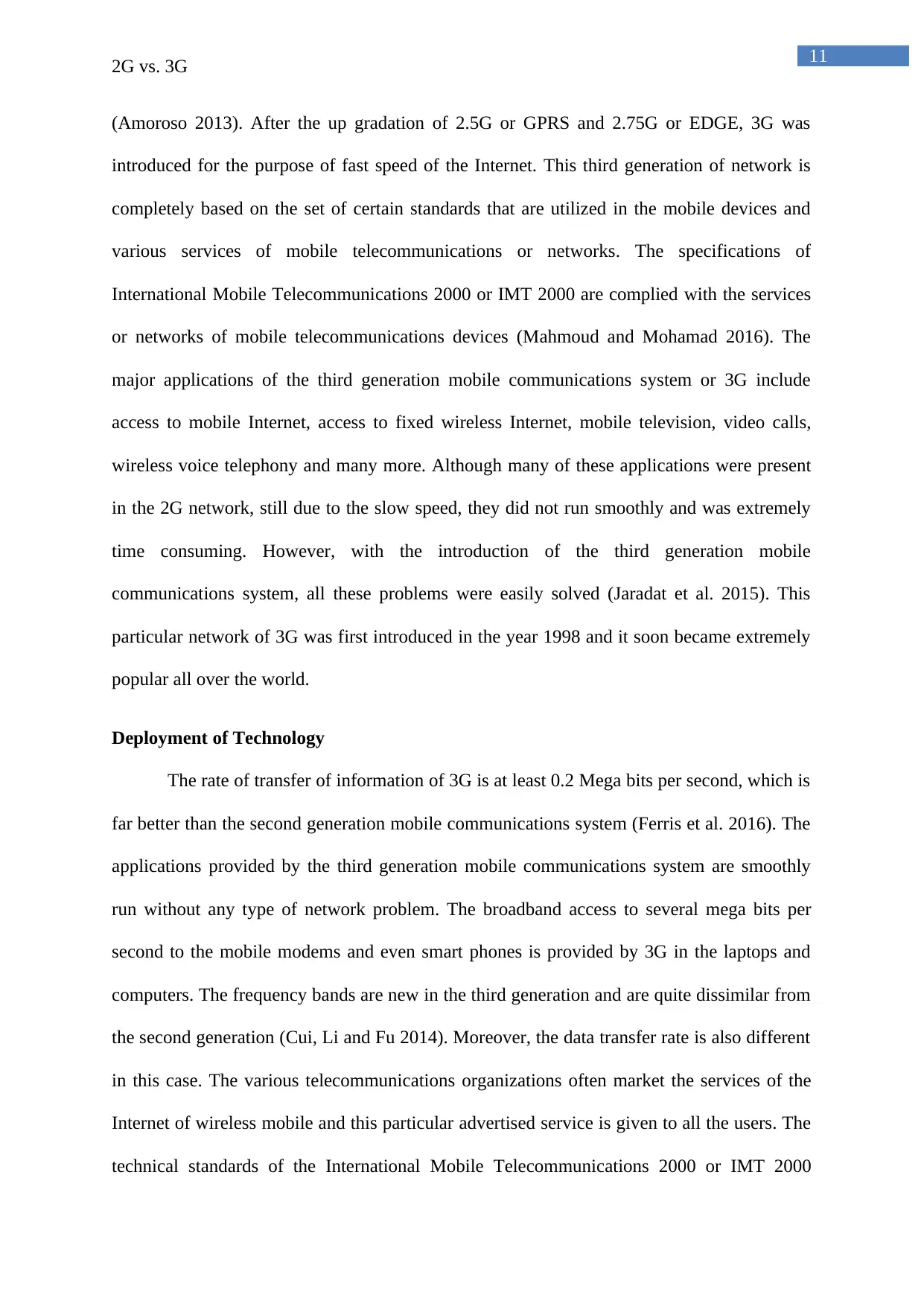
11
2G vs. 3G
(Amoroso 2013). After the up gradation of 2.5G or GPRS and 2.75G or EDGE, 3G was
introduced for the purpose of fast speed of the Internet. This third generation of network is
completely based on the set of certain standards that are utilized in the mobile devices and
various services of mobile telecommunications or networks. The specifications of
International Mobile Telecommunications 2000 or IMT 2000 are complied with the services
or networks of mobile telecommunications devices (Mahmoud and Mohamad 2016). The
major applications of the third generation mobile communications system or 3G include
access to mobile Internet, access to fixed wireless Internet, mobile television, video calls,
wireless voice telephony and many more. Although many of these applications were present
in the 2G network, still due to the slow speed, they did not run smoothly and was extremely
time consuming. However, with the introduction of the third generation mobile
communications system, all these problems were easily solved (Jaradat et al. 2015). This
particular network of 3G was first introduced in the year 1998 and it soon became extremely
popular all over the world.
Deployment of Technology
The rate of transfer of information of 3G is at least 0.2 Mega bits per second, which is
far better than the second generation mobile communications system (Ferris et al. 2016). The
applications provided by the third generation mobile communications system are smoothly
run without any type of network problem. The broadband access to several mega bits per
second to the mobile modems and even smart phones is provided by 3G in the laptops and
computers. The frequency bands are new in the third generation and are quite dissimilar from
the second generation (Cui, Li and Fu 2014). Moreover, the data transfer rate is also different
in this case. The various telecommunications organizations often market the services of the
Internet of wireless mobile and this particular advertised service is given to all the users. The
technical standards of the International Mobile Telecommunications 2000 or IMT 2000
2G vs. 3G
(Amoroso 2013). After the up gradation of 2.5G or GPRS and 2.75G or EDGE, 3G was
introduced for the purpose of fast speed of the Internet. This third generation of network is
completely based on the set of certain standards that are utilized in the mobile devices and
various services of mobile telecommunications or networks. The specifications of
International Mobile Telecommunications 2000 or IMT 2000 are complied with the services
or networks of mobile telecommunications devices (Mahmoud and Mohamad 2016). The
major applications of the third generation mobile communications system or 3G include
access to mobile Internet, access to fixed wireless Internet, mobile television, video calls,
wireless voice telephony and many more. Although many of these applications were present
in the 2G network, still due to the slow speed, they did not run smoothly and was extremely
time consuming. However, with the introduction of the third generation mobile
communications system, all these problems were easily solved (Jaradat et al. 2015). This
particular network of 3G was first introduced in the year 1998 and it soon became extremely
popular all over the world.
Deployment of Technology
The rate of transfer of information of 3G is at least 0.2 Mega bits per second, which is
far better than the second generation mobile communications system (Ferris et al. 2016). The
applications provided by the third generation mobile communications system are smoothly
run without any type of network problem. The broadband access to several mega bits per
second to the mobile modems and even smart phones is provided by 3G in the laptops and
computers. The frequency bands are new in the third generation and are quite dissimilar from
the second generation (Cui, Li and Fu 2014). Moreover, the data transfer rate is also different
in this case. The various telecommunications organizations often market the services of the
Internet of wireless mobile and this particular advertised service is given to all the users. The
technical standards of the International Mobile Telecommunications 2000 or IMT 2000
⊘ This is a preview!⊘
Do you want full access?
Subscribe today to unlock all pages.

Trusted by 1+ million students worldwide
1 out of 27
Related Documents
Your All-in-One AI-Powered Toolkit for Academic Success.
+13062052269
info@desklib.com
Available 24*7 on WhatsApp / Email
![[object Object]](/_next/static/media/star-bottom.7253800d.svg)
Unlock your academic potential
Copyright © 2020–2025 A2Z Services. All Rights Reserved. Developed and managed by ZUCOL.




